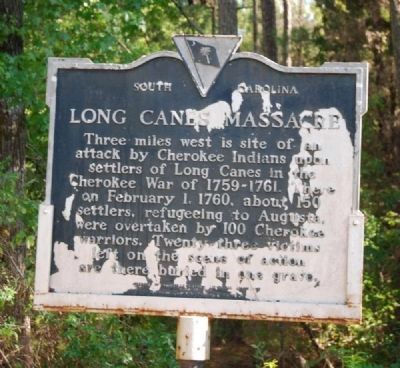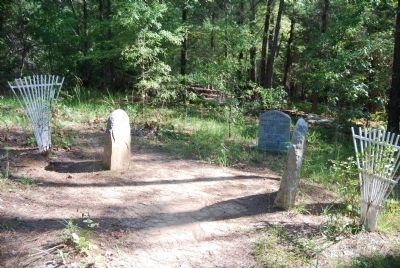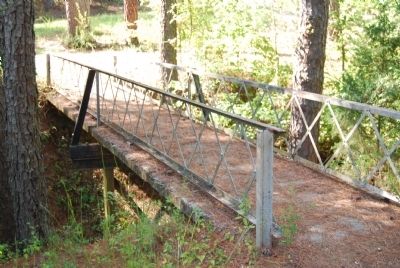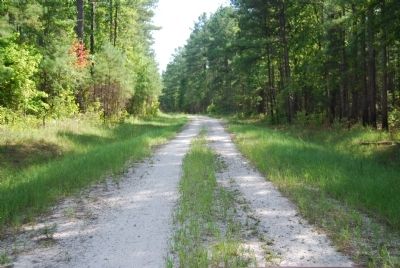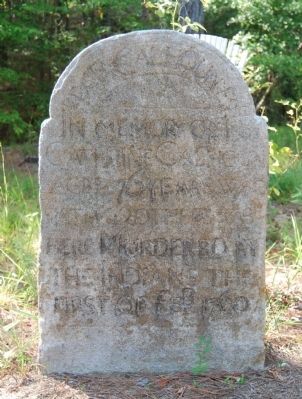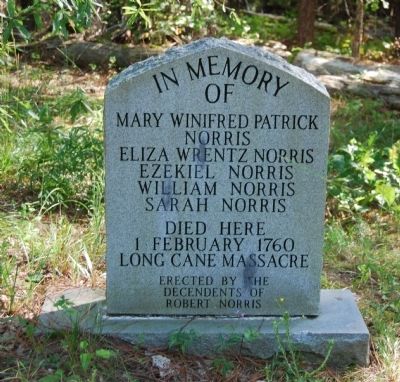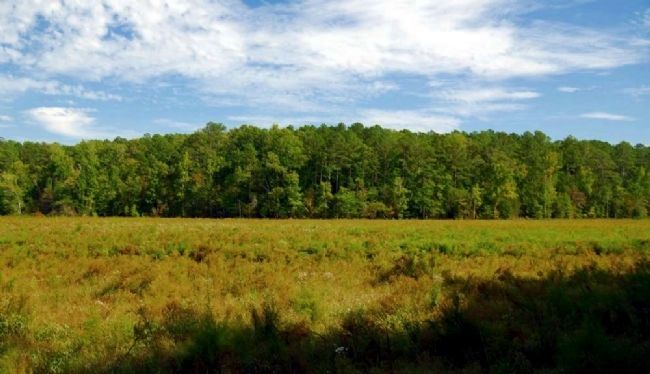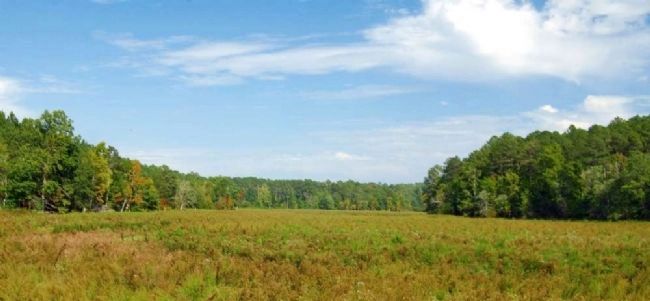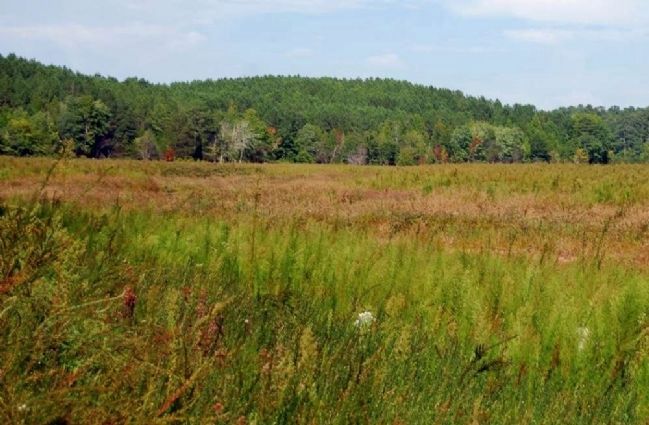Troy in McCormick County, South Carolina — The American South (South Atlantic)
Long Canes Massacre
Three miles west is the site of an attack by Cherokee Indians upon settlers of Long Canes in the Cherokee War of 1759-1761. There on February 1, 1760, about 150 settlers, refugeeing to Augusta, were overtaken by 100 Cherokee warriors. Twenty-three victims left on the scene of action are there buried in one grave.
Erected 1976 by Abbeville District Historical Association, Town of Troy, McCormick County Historical Commission. (Marker Number 33-12.)
Topics and series. This historical marker is listed in these topic lists: Colonial Era • Military • Native Americans • Notable Events • Settlements & Settlers. In addition, it is included in the South Carolina, McCormick County Historical Commission series list. A significant historical month for this entry is February 1774.
Location. 33° 59.7′ N, 82° 20.35′ W. Marker is in Troy, South Carolina, in McCormick County. Marker is on Charleston Road West when traveling south. Marker is located at the end of an unnamed and unnumbered road, off of Charleston Road West (SC 33-117). Touch for map. Marker is in this post office area: Troy SC 29848, United States of America. Touch for directions.
Other nearby markers. At least 10 other markers are within 6 miles of this marker, measured as the crow flies. A different marker also named Long Canes Massacre (approx. 2.4 miles away); Long Cane Associated Reformed Presbyterian Church (approx. 2.4 miles away); Battle of Long Cane (approx. 4.1 miles away); Badwell / Badwell Cemetery (approx. 4.6 miles away); John De La Howe Forest (approx. 5.2 miles away); John De La Howe School Lethe Farm Trail (approx. 5.2 miles away); De La Howe Hall (approx. 5.3 miles away); John De La Howe / John De La Howe School (approx. 5.4 miles away); John De La Howe School (approx. 5.6 miles away); New Bordeaux Worship Site (approx. 5.6 miles away). Touch for a list and map of all markers in Troy.
More about this marker. This marker is a duplicate of the one in Troy, Greenwood County, SC, near the intersection of Church and Main Sts and Highway 10.
Also see . . .
1. Long Canes Massacre of 1760. Next 10000 website entry:
Photos and information from a 2007 visit to the site. This link includes copies of the contemporary accounts of the massacre. (Submitted on September 21, 2008, by Brian Scott of Anderson, South Carolina.)
2. Long Cane Massacre Site. South Carolina Department of Archives and History website entry:
The Long Cane Massacre Site is significant to the history of exploration and settlement in South Carolina and for its association with the Cherokee War of 1760-61 and the Calhoun settlement of Long Cane. (Submitted on September 21, 2008, by Brian Scott of Anderson, South Carolina.)
3. Anglo-Cherokee War. Wikipedia entry:
The Anglo-Cherokee War (1758Ė1761) (Cherokee:"war with those in the red coats" or "war with the english"), also known (from the Anglo-European perspective) as the Cherokee War, the Cherokee Uprising, the Cherokee Rebellion, was a conflict between British forces in North America and Cherokee Indians during the French and Indian War. (Submitted on November 27, 2009, by Brian Scott of Anderson, South Carolina.)
4. Ghosthunting -- Long Canes Massacre Site. YouTube video (10m 59s):
Night time investigation of the Long Canes Massacre site in McCormick County, South Carolina. (Submitted on November 27, 2009, by Brian Scott of Anderson, South Carolina.)
Additional commentary.
1. The Long Cane Massacre
A granite stone in a field marks the common grave of twenty-three colonists who were buried after the Cherokees attacked in reprisal for what they consider a violation of the boundary line for white settlement. This was the first of a series of similar attacks in the area.
Alerted that the Cherokees were on the warpath, the 150 colonists who suffered the bloody assault were fleeting to the safety of Fort Moore in Augusts. Among those killed and buried here was grandmother of John C. Calhoun. Other members of the Calhoun family did all they could to escape the massacre. In the midst of the attack, William Calhoun cut a horse loose from his wagon, put his wife atop it, and instructed her to make haste for the fort. As the Indians screamed their war cries, she escaped into the forest. Later that night, she stopped to rest in a cabin, where she delivered a son. (Source: Touring South Carolina's Revolutionary War Sites by Daniel W. Barefoot (1999), pg 137.)
— Submitted November 27, 2009, by Brian Scott of Anderson, South Carolina.
2. Long Cane Massacre
One of the most terrible incidents of this uprising was the massacre of the Calhouns. A party, of whom Patrick Calhoun was one, attempting to remove their wives, children, and most valuable effects to Augusta, were attacked by the Cherokees on the 1st of February, 1760, and some fifty, mostly women and children, were slain. Many children were found, after the massacre, wandering in the woods. One man found nine of these little fugitives; some had been cut and left for dead, others were found in the bloody field scalped, yet living. Two little girls, daughters of Mr. William Calhoun, —brother of Patrick, — were carried into captivity. The elder of them was, after some years, rescued; the other was never heard of. The scene of this massacre is on a descent just before reaching Patterson's bridge. Attacked at the moment when they had stopped to make an encampment, and entangled by their wagons, they could offer but little resistance. Some, however, were so fortunate as to escape; cutting loose the horses and favored by night they fled to another part of the company, which was making their way to the Waxhaws. Among the slain was the mother of the party, Mrs. Catherine Calhoun, and a curious stone, engraved by a native artist, marks the spot where she fell among her children and her neighbors. Patrick Calhoun, who returned to the place where the tragedy had happened to bury the dead, found twenty dead bodies inhumanly mangled. The Indians had set fire to the woods, had rifled the carts and wagons, but had not destroyed them. Patrick Calhoun represented the settlement as at the time amounting to about two hundred and fifty souls, fifty-five to sixty-five of whom were fighting men, but they were not then in a condition to resist. (Source: The History of South Carolina Under the Royal Government, 1719-1776 by Edward McCrady (1899), pgs 342-343.)
— Submitted November 27, 2009, by Brian Scott of Anderson, South Carolina.
3. Crying Out for Vengence: The Long Canes Massacre
February 1, 1760, was a cold, winter day in the Calhoun settlement at Long Canes. During the morning the settlers received the alarm of an impending attack planned by Indian warriors from the Lower Towns and the Middle Towns of the Cherokee Nation. Risking her life, Cateechee, a Cherokee maiden, rode some 70 miles on horseback from her Keowee home in the Lower Towns to warn settlers. The daring dash by Cateechee probably saved the Long Canes settlement from total annihilation.
The settlers hastily began preparations to flee some 60 miles south to Toblerís Fort at Beech Island in New Windsor Township, just across the Savannah River from Augusta.
John Tobler, a Swiss settler, had set up a thriving plantation there that included an ironworks, a clock making business, and a printing shop that published The South Carolina Almanack. He, like William Calhoun, was engaged in Indian trade. It is likely that the Calhouns and Tobler were already well acquainted. Tolbert's extensive compound was enclosed inside a sturdy palisade fort.
The decision to flee would prove to be a fatal one, traveling in loaded wagons whereas the attackers were on horseback. With a few
hours of work building a stockade the men could have probably successfully defended their families. But, of course, the settlers did not know the imminence of the impending attack.
Within hours of the warning, a first group of over 100 people left the Long Canes and would reach Toblerís Fort unmolested.
Shortly thereafter the rest of the settlers moved out in a wagon train of about 150 people. Travel was hampered due to the ground being soggy wet from recent rainy weather. After traveling a few miles they reached Long Cane Creek. They experienced great difficulty in crossing the creek and climbing the hill on the east side. By that time it was late and the decision was made to make camp for the night.
Meanwhile, a Cherokee war party of about 100 Indian braves, reportedly led by Chief Big Sawny and Chief Sunaratehee, arrived at the Long Canes settlement and found it abandoned. They pursued the trail of the settlers for a while and decided to cease pursuit. At the moment they were about to turn around, they faintly heard shouts of the fleeing settlers as they probably were making the creek crossing. The war party quickly resumed pursuit, crossed the creek at another site and went into hiding.
When at the settlersí most defenseless moment, the Indians attacked. The campsite was at once a scene of total pandemonium. In the wild confusion only a few of the 55 to 60 fighting men could lay hand on their guns. Women and children scrambled for any available cover and became separated. Casualties among the settlers mounted very quickly. The men were able to hold off the attacking Indians for no more than a half-hour. Realizing the futility of further resistance the surviving settlers, aided by then night, assembled as best they could and fled on horses, leaving behind the wagons containing all their earthly possessions.
The next day survivors reached the safety of Toblerís Fort. Immediately Patrick Calhoun sent a messenger to Charles Town to inform the governor of the massacre.
In the short half-hour the Long Canes settlers suffered 56 killed and a number taken captive. James Calhoun, commander of the settlement and eldest of the Calhoun brothers, was killed. Five of those killed were members of the Norris family: Robert Norrisí mother, wife, two sons and one daughter. Margaret Clarkís husband was killed, and her six-year-old daughter captured.
The Cherokee raiding party sustained 21 killed and a number wounded. Among the killed was Chief Sunaratehee.
At the beginning of the battle William Calhoun saw his daughter Catherine, 7, killed, and his daughters Anne, 4, and Mary, 2, taken captive. Panic-stricken, he cut a horse loose from a wagon, and loaded his pregnant wife, Agnes Long Calhoun, and only remaining child, Joseph, 9. He told them to head south toward Toblerís Fort and to try and overtake the group that had left Long Canes first. Somehow she escaped and rode hard until dark but did not catch up with the first group. She did come upon a deserted cabin and found some food. Now, lost from both groups and not knowing their fate, at dawnís first light, Agnes Calhoun mounted the horse with Joseph and headed south. The two unlikely refugees made it to Toblerís Fort in good condition. A few days later on February 18th a son Patrick was born to William and Agnes Calhoun.
Two or three days after the massacre Patrick Calhoun, with a militia troupe, returned to the battle site. At one location they found the bodies of 23 victims, including that of Catherine Calhoun, the 76-year-old matriarch of the Calhoun family. The victims were women and children who had all hovered around a large tree in a vain effort to escape death. They were buried in a mass grave where they were killed. The other victims were buried at another nearby location in a second mass grave near to where they fell.
Children were found wandering in the woods. One man found nine children, some of whom had been cut with tomahawks and left for dead. Others were found on the bloody ground scalped, yet still living.
Rebecca Calhoun, 15, daughter of Ezekiel and Jean Ewing Calhoun, was found hiding in the woods. She revealed that she has escaped by crouching unnoticed in a cane brake. Five years later on March 19, 1765, Rebecca became the wife of Andrew Pickens, who, during the American Revolution became an illustrious patriot general. She was the mother and the grandmother of governors of South Carolina – Andrew Pickens, 1816-1818, and Francis W. Pickens, 1860-1862.
The militia then left the battle site and headed back to investigate the status of the settlersí homes that they found damaged and pillaged by the Indians. On the road some distance from the battle site the body of another victim was found. The little blue-eyed girl had suffered a terrific tomahawk blow to the head. Apparently, she, having regained consciousness, had attempted to return to her home in the Calhoun settlement. Her body was wrapped in a blanket and buried beside a large poplar tree with a field stone to mark the grave. As late as the 1920s, the gravesite could be identified because farmers had left a clump of trees in their original state to cloak the location.
The Long Canes settlers remained for several weeks in the security of John Toblerís fortified compound at Beech Island. The compound was well stocked with provisions. Three weeks after his people had nearly been wiped out, Patrick Calhoun was in Charles Town pleading for military aid to protect the Long Canes settlement. The South Carolina Gazette reported, “Mr. Patrick Calhoun, one of the unfortunate Settlers at Long-Canes, who were attacked by the Cherokees on the 1st Instant, as they were removing their wives, children and best effects, to safety, is just come to town, and informs us that the whole of those settlers might be about 250 souls, 55 or 60 of them fighting men; that their loss in that affair amounted to about 50 persons, chiefly women and children, with 13 loaded wagons and carts; that he had since been at the place where the action happened, in order to bury the dead; and that he believes all the fighting men would return to and fortify the Long-Canes Settlement, were part of the Rangers so stationed as to give them some Assistance and Protection.”
When the situation was adequately improved, the Long Canes refugees left Toblerís Fort at Beech Island, and established a temporary home at the Waxhaws settlement of Scots-Irish near present-day Lancaster. Many of the Long Canes settlers had stopped over at the Waxhaws on their way to locate at Long Canes and some had relatives there.
Two days after the massacre at Long Canes, on February 3rd the fort at nearby Ninety Six was attacked by a force of over 200 Cherokee Indians led by Chief Young Warrior. All the surrounding buildings were burned but the fortís defenders withheld the attack. The fortís commander wrote to Governor William Henry Lyttleton, “We fattened our dogs with their (the Indians) carcasses.” In reply the governor directed the commander to, “display their scalps neatly ornamented to the tops of our (fortís) bastions!”
A Cherokee war party attacked the Stevens Creek settlement, which was located about ten miles southeast of present-day Modoc, killing twenty of the settlers. 170 survivors, under the leadership of George Bussey, fled for safety to Fort Moore, which was located a few miles from Tobler's Fort.
The Cherokee raiding parties across the upstate varied in number from a dozen or so to over a hundred. Only the stockade forts, which within a week of the Long Cane massacre, dotted the South Carolina frontier, prevented wholesale carnage in the upstate. These hastily constructed forts were in time improved and strengthened so as to provide a safe haven for settlers. (Source: The Making of McCormick County by Bobby F. Edmonds (1999), pgs 17-21.)
— Submitted November 27, 2009, by Brian Scott of Anderson, South Carolina.
4. Anne Calhoun Returned
After the end of the Cherokee War, there was a prisoner release by the Cherokee Indians, brought about through the negotiations of Andrew Pickens. Upon the appointed day, William Calhoun attended the proceedings with the obscure hope that he might find his Anne and Mary, who had been carried away by the Indians more than a year earlier. Anne had been 4 and Mary 2. Watching with eagerness as each prisoner was brought forward, he at last saw Anne, and instantly identified her by a burn scar. She had the appearance of an Indian maiden and spoke not a word of English.
But the day also brought sad news when it was revealed that Mary Calhoun was, on the day of the massacre, scalped and her body thrown into Long Cane Creek.
Anne Calhoun, then nine years old, learned to speak English again but would never learn to read or write. She would throughout her life wear moccasins made of the bark of certain trees. A Calhoun family descendant wrote that Anne retained the character of an Indian woman and “was almost hated by her family.” Anne later in life would sadly assert that she was punished by the Indians to make her cultivate their ways and, in turn, admonished by her family to revert to theirs.
Anne married Isaac Matthews, a nearby farmer, in 1784, when she was 29. They raised six children, Joseph, Mary, Nancy, Ann, John, and Lewis. The descendant wrote, “she did not fancy the harsh name of Isaac so she called her lover Zacky. Her great strength of endurance and energy lent a charm to the young farmer as a helpmate.”
Anne often longed for her wild Indian life and would steal away sometimes at early dawn and spend the whole day in the woods. Into the dense forest she would go, she said to whisper to the spirits that she could not see, but could hear them gliding away from tree to tree. Once Zacky followed her and found her eating lizards and frogs. She had imbibed the old way of eating. She never revealed emotions or got excited.
Her children grew up and left her. Then in 1801 Zacky died. Afterward she led a lonely desolate life. Her brother, Joseph Calhoun, owned Calhoun Mill. During his life Anne was allowed to get anything she wished from the mill. Every week she could be seen on the old white mare wending her way with two sacks, for meal and flour. She enjoyed telling children stories of her life among the Cherokees.
On her last Christmas, a relative made Anne a muslin cap with two wide frills on it and a kerchief to match. The old lady was much pleased with the present and thanked the giver saying, “Itís too nice to wear now. I will save it until I die. You must put it on me. Then when Zacky will meet me, he will say, Anne, how beautiful you look!” (Source: The Making of McCormick County by Bobby Edmunds (1999), pgs 28-29.)
— Submitted November 27, 2009, by Brian Scott of Anderson, South Carolina.
5. White Child Kept Twelve Years
The Atlanta Journal
November 9,1924
How the Indians captured little Ann Calhoun at he age of five and held her prisoner for twelve years and after her return to civilization Ann had frequented reversions to the wild habits acquired during her captivity, is the strange story woven into the hardships and perils of America's early setters, told by one of Ann descendants, her grand niece, Mrs. Tammy J. Marshall, now ninety three years old and living in Abbeville South Carolina.
Abbeville just across the border from Georgia, is full of delightful ante bellum mansions, in one of which the Confederate cabinet held it's last meeting, near the site of Fort Pickens, with a tiny cannon still mounting guard. And in the other direction lies Long Cane Cemetery, where sleeping many old Virginians, who about 176_ came a great migration to the Long Cane District and founded the first considerable settlement in western South Carolina. The Hammonds, Conways, Uus, Washingtons, Balls, Tuslus, Strathers, Garrets with many other old families arrived in early settlement trains.
Mrs. Marshal is one of the most interesting things about Abbeville of today. A direct link with the romantic past. At the age of ninety three she still thinks clearly and is beautiful with the rare delicacy of an old piece Seures China, and the object of veneration to the throng of kind people who gather now and then about her. And any stranger who visits the precincts of her deep Magnolia Gardens.
The Calhouns, whom Mrs, Marshall is directly descended, had lived in Abbeville but a short while when the horrible massacre of Long Cane was enacted. William Calhoun (born 1723) had married Agnes Lond (born 1733) and at the time of the massacre had the following children, Joseph, Catherine, Mary and Ann.
The settlers at Long Cane numbered 250 souls, mostly women and children, had heard of an uprising of the Cherokee Indians, and on the morning of February 1, 1796, the entire colony was busy packing wagons and getting ready to flee to Tobus Fort near Augusta, when the blood curdling and savage warhoops of the was heard. The ammunition and the guns of the men were mostly packed in the wagons and the horses hitched to the vehicles. Quicker that it takes to tell, William Calhoun saw his mother age seventy-six killed by the savages, and his little daughter, Catherine, scalped and dying and little Ann, five, and Mary, three, sized and born off by the savages.
Panic stricken and almost paralyzed with horror, he cut a horse loose from a wagon and placed upon it's back, his wife and only remaining child, Joseph, a boy of five years old and bade them flee toward Augusta. The bereaved mother rode all day and at night fall, coming to a vacant house which had to be left by some family, took refuge in it, following her flight from the Indians. In her desolation and bereavement, with no eye to see, no ear to hear, no hand to help save God, she gave birth to a son and called him Patrick.
With her husband and murdered children behind her and danger all around her, daring not to stay where she was, and not physically able to go forward, here was a situation seldom seen in life, but hers was a stern Pioneer Character, and realizing she must move on even if she lost her on life, to try to reach Fort Tobus to save the lives of her two sons, she mounted her horse at dawn, and with little Joseph and with the new baby rode forth safely, nursed back to health and strength. It may be said that Patrick grew to be a fair youth and fought in the War of the Revolution and was killed in the last year of the war at the age of twenty-nine.
Nothing but doubtless bravery saved the men of Long Cane. The Calhoun brothers with thirteen other white men, maintained a desperate fight with the Cherokees, until over whelmed by superior forces and had to retreat. In the massacre there was fifty persons killed, mostly women and children. William Calhoun returned to Long Cane three days later, to bury his mother, three little nieces, Catherine and Mary, who had been killed, and besides his own kin, he found twenty bodies inhumanly mangled. Another man found nine little fugitive children wandering in the woods. Some had been left for dead, others in the bloody field scalped.
For twelve long years Ann lived with the Indians, enduring untold hardships, at times nearly starving to death. On the day of her capture she had seen her sister Mary scalped and her body thrown into the creek, because she was to young to walk. Ann escaped the same fate only by promising to run and when ever the poor frighten child would stop for breath, she would be severely beaten.
After Ann was exchanged by treaty, near Pendleton, she came back to live with her parents. Ann said her life among the Indians had been a hard one, the Indians had nearly beaten her to death to make her eat lizards, snakes and raw meats, and when she got to her own people, they would punish her to make her stop eating such foods and forced her to eat cook things. "Ann would never learn to read or write even her own name" said Mrs. Marshall, "she always wore sandals made from the bark of certain trees." Nothing could induce her to wear shoes. Her eldest son took up the shoemaker trade. When Ann was very old he made her a pair of shoes made of leather, but as soon as she went into the house they were taken off summer or winter. When Ann was twenty years old she married Issac Mathews, a nearby farmer who had a tract of land granted by King George. Aunt Ann did not like the harsh name of Issac, so she called him "Zacky." He in turn was not captivated by Ann's personal appearance, for she was awkward and almost hated by her family by keeping appearances taught her by squaws. But her great strength and endurance did have charm for the young farmer as a possible help mate, for he not was gifted with industrious habits. Indeed Ann always said "Zacky is mighty good but he is lazy." However with three children they were always happy.
Aunt Ann often longed for her wild Indian life, and she would sometimes steal away at early dawn and send the whole day in the woods. She would go into the densest forest, she said, "to witness to the spirits, which one could not see, but she thought she could hear gliding from tree to tree." Once her husband followed her and he found her eating lizards and frogs. She had gone back to her Indian ways.
Aunt Ann, like the Indians, was never emotional nor excited. After her husband's death, when she spoke of the event to her friends, she said "I behaved very well. I never laughed or cried." When her children grew up, they married and left her alone. After Zacky died Aunt Ann had a desolate life. Her brother, Joseph, my grandfather owned Calhoun Mills. During his life, Aunt Ann was allowed get anything she wanted from the mill. And every week she could be seen on her old white mule, riding with two sacks for flour and meat. After my grandfather's death the same kindness was always shown Aunt Ann by my father. On one occasion, she rode up to the mil and handed the miller an exceeding large sack. Surprised, he asked her if she wanted it filled with flour. "No. indeed, she quickly replied, "I have had only one bite of meat for a week. I am meat hungry. I want a pig, no let it be a shoat, no you just let it be a good size hog."
I remember when a big cake, made with a pound of sugar, a pound of butter and a good round dozen of eggs, would appear on the table and our mother would began to slice it, we children would cry out "give me a good sizehog."
For many years my father's health was not good. When he was depressed he would have a horse saddled and would send for Aunt Ann to come and stay awhile and cheer him up with her Indian stories. And these stories he would often tell to the children, long after Aunt Ann had passed away.
Christmas before Aunt Ann's death, my mother made her a muslin cap with wide frills on it, and also a handkerchief to match. Old Aunt Ann was much pleased with the present and thanked my mother, but she said "It is too nice to wear now. Just save it until I die. Then put it on so when Zacky will meet me in Heaven. He will say, 'Ann how beautiful you look'."
"Aunt Ann's only son, Joseph Mathews, had twelve children, many of these married and moved west, but some of the grand children are living in Abbeville now."
— Submitted November 27, 2009, by Brian Scott of Anderson, South Carolina.
Credits. This page was last revised on February 1, 2022. It was originally submitted on September 21, 2008, by Brian Scott of Anderson, South Carolina. This page has been viewed 13,745 times since then and 357 times this year. Photos: 1. submitted on December 8, 2009, by Brian Scott of Anderson, South Carolina. 2, 3, 4, 5, 6. submitted on September 21, 2008, by Brian Scott of Anderson, South Carolina. 7, 8, 9. submitted on December 8, 2009, by Brian Scott of Anderson, South Carolina.
